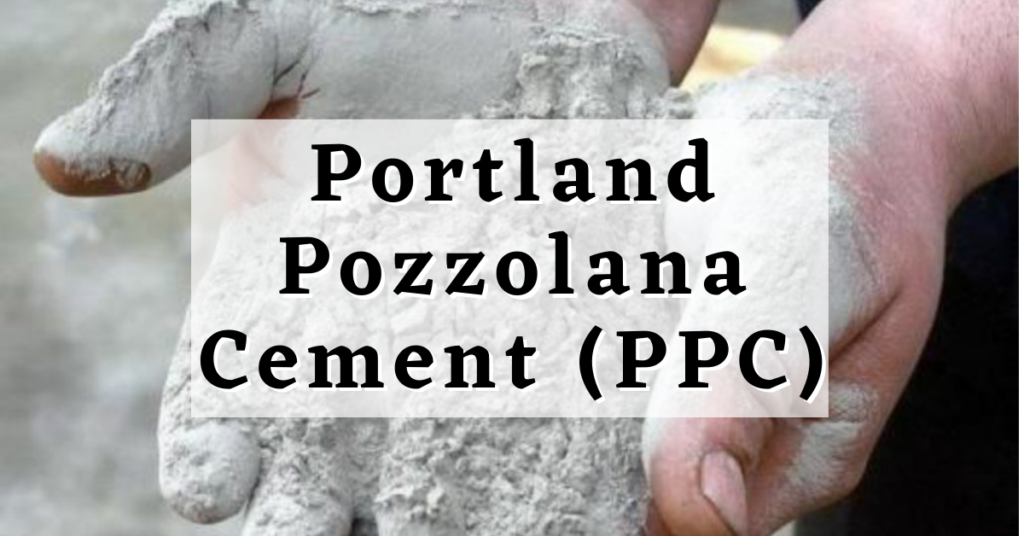Portland Pozzolana Cement (PPC) – It is a kind of Blended Cement which is produced by either intergrinding of OPC clinker along with gypsum and Pozzolanic materials (Pozzolanas) in certain proportions or grinding the OPC clinker, gypsum and Pozzolanas separately and thoroughly blending them in certain proportions.

Pozzolana is a natural or artificial siliceous material in a reactive form. It may be further discussed as siliceous and aluminous material which itself possesses little, or no cementitious properties but will in finely divided form and in the presence of moisture, chemically react with Calcium Hydroxide, Ca(OH)2, (the unwanted by-product of cement hydration) at ordinary temperature to form compounds possessing cementitious properties, C-S-H gel. Following Pozzolanic reaction takes place;
Pozzolanic reaction stands a simple acid-base reaction between Ca(OH)2, and Silicic Acid, H4SiO4 or Si(OH)4. Simply, this reaction can be schematically represented as follows:
Ca(OH)2 + H4SiO4 → CaH2SiO4.2H2O; or simply
Ca(OH)2+ Pozzolana + Water → C-S-H (Cement Gel)
It is essential that Pozzolana be in a finely divided state as it is only then that silica can combine with calcium hydroxide liberated by the hydrating Portland Cement in the presence of water to form stable calcium silicates which have cementitious properties. The natural and artificial pozzolanic materials commonly used are:
- Fly Ash
- Volcanic Ash
- Calcined Clay
- Silica Fumes
An unique characteristic of natural pozzolanas is its inherent ability to actually heal or re-cement cracks within the concrete by means of the continuation of pozzolanic reaction with the calcium hydroxide freed from the cement hydration reaction. This results in the filling up of most of the gaps inside the hardened concrete matrix.
The most commonly used Pozzolana in production of Portland Pozzolana Cement, PPC, is Fly ash; an Artificial Pozzolana, which is by-product of coal burning thermal power plants. In PPC, quantity of Fly Ash varies from 10-40% and is usually around 20 %.
PPC offers lesser heat of hydration with slower rate of gain of strength especially in early days; up-to 7 days. Use of Pozzolanas in PPC in no-way contribute in gain of strength at early days.
Reactions usually continue for longer time period at the slower rate, thus need more curing time while using PPC for concreting works.
Also, PPC is expected to gain the strength equivalent to 28 days strength of OPC only at later ages; almost at 40 – 50 days after casting. But it all depends on the amount of Fly Ash used in the manufacture of PPC.
Why Portland Pozzolana Cement, PPC, is desirable ??
Portland Pozzolana Cement, PPC, of course offers some superior properties to that of Ordinary Portland Cement, OPC; provided that the Pozzolanas used in the production of such PPC are in right quantities and of good quality; a reactive one.
Use of PPC in making concrete is highly desirable from durability point of view because of its Pozzolanic action. In due course of time, It produces a more durable and hence stronger concrete than OPC. PPC is highly desirable in concrete structures that remain in contact with water and in marine/coastal and humid environments.
Hydration of Cement produces a large amount of free Calcium Hydroxie, Ca(OH)2 as seen from the reactions above. Presence of free Calcium Hydroxide, Ca(OH)2, in hardened concrete is undesirable as it could badly affect the durability of concrete especially in hydraulic and marine structures. It reacts with water leading to the leaching action thereby forming the voids in concrete. Also, Ca(OH)2 reacts with Sulphates present in soils leading to Sulphate Attack that often happens in foundation concrete.
All these undesirable effects of Calcium Hydroxide in hardened concrete can be highly minimized by use of Portland Pozzolana Cement, PPC, that consumes this Ca(OH)2 thereby converting it into C-S-H gel that densifies the hardened concrete. Densification process makes concrete more impermeable; hence durable one, in due course of time.
Advantages & Uses of Portland Pozzolana Cement
Less Heat of Hydration : Makes it suitable for mass concreting work and hot weather concreting work.
Higher Resistance Against Aggressive Water Conditions : Makes it suitable for marine and under water concrete structures.
Higher Resistance Against Sulphate Attack : Makes it suitable for adverse conditioned concrete structures.
Economical : Costly cementious clinker is replaced up-to 40% by cheaper Fly Ash; the power plant waste.
Properties of Portland Pozzolana Cement (PPC) in Comparision to OPC
- Low Early Strength
- Generates Lesser Heat of Hydration
- Requires Increased Curing Time (about 20-30% more than OPC)
- Improves Mix Workability
- Reacts less with Sulphates and Salts
- Produces more Impermeable Concrete
- Provides better protection againt Aggressive Environments
Which is best – Portland or pozzolana cement?
Check Para 2.
What is the rate per bag of Portland Pozzolana cement, in your area, city, town ? You can share with us by commenting below.